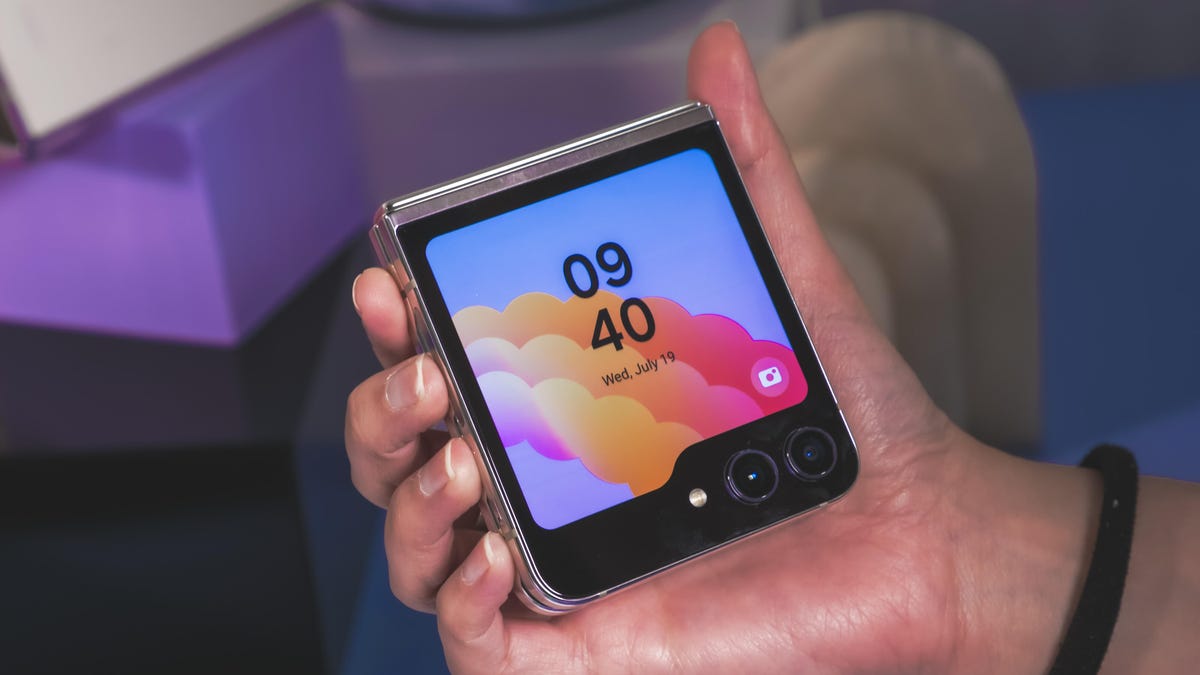 Why You Can Trust CNET
Why You Can Trust CNET New Foldable Phones Convinced Me Two Screens Are Better Than One
Commentary: With the Galaxy Z Flip 5, Motorola Razr Plus and Google Pixel Fold, tech giants are closer to proving that foldable phones can be truly useful.

Samsung's Galaxy Z Flip 5 has a much larger cover screen than the Z Flip 4.
Foldable phones have been around for almost half a decade, but they still account for only a small portion of the mobile phone market. There are a few good reasons why: Such phones are expensive, less durable than standard mobile devices and have a visible crease running across their displays.
But most importantly, foldable phones still lack a so-called "killer app:" An app or feature that defines their purpose and is compelling enough to convince people to buy them. With new foldables like the Samsung Galaxy Z Flip 5, Motorola Razr Plus and Google Pixel Fold, tech giants are taking a step toward changing that. And the "killer app" may not be an app at all, but rather a secondary screen.
Foldable phones in 2023
Products featured in this story:
- Samsung Galaxy Z Flip 5: $1,000 at Samsung (as low as $400 with trade-in)
- Motorola Razr Plus: $1,000 at Motorola(as low as $449 with trade-in)
- Google Pixel Fold: $1,799 at Google (trade-in options available)
All three phones share a common theme that stretches beyond their foldable shape. Samsung, Google and Motorola are all exploring the usefulness of having two screens on your phone instead of just one. Each phone has an external cover screen that's large enough to comfortably use apps without opening the phone. Google, Samsung and Motorola also take that idea a step further by experimenting with how those two screens can be used in tandem to enhance photography and other features.
While phones like the Z Flip 5, Razr Plus and Pixel Fold are still new, I'm already starting to see the promise behind having a phone with two screens that can serve different purposes.
The Galaxy Z Flip 5 and Motorola Razr Plus may be the best examples of this so far. Both devices have external screens that are roughly the same size as the display on an iPhone 4. That's considered tiny by today's standards, but these screens are large enough to send text messages, browse directions on Google Maps, take selfies and scroll through news headlines without opening the phone.
Flip phones with cover screens like these are a great middle ground between a smartwatch and a smartphone. After years of using phones with giant screens that measure 6 inches or larger, I appreciate having a screen that fits in the palm of my hand. And unlike a smartwatch, I don't have to twist my wrist to read an email or check my calendar.
You can fit a full keyboard on the Motorola Razr Plus' screen.
The Pixel Fold's cover screen didn't leave as strong of an impression on me as the Razr Plus' or Z Flip 5's, but it's still one of the few advantages it has over Samsung's Galaxy Z Fold line. The outer display on the Pixel Fold has a wider shape, more closely resembling a regular phone when closed. That goes a long way in making the Pixel Fold feel more natural, enabling it to strike a better balance between tablet and phone. While the main internal display on the Z Fold looks better than the Pixel Fold's in terms of brightness and boldness, Samsung's external display feels elongated and skinny compared with the Pixel Fold. As a result, it's less enjoyable to use in phone form.
The Pixel Fold's cover screen makes it feel more like a regular phone when closed.
However, there's more potential behind these dual-screen designs that companies like Samsung, Google and Motorola are just starting to tap into. What I'm most excited about is the way these cover displays and internal screens may work together in the future. Motorola and Samsung are starting with the camera. Both phones can show a preview of a photo before you hit the shutter button, letting friends and family see how they look before the image is captured.
Google is launching a language translation feature in Android 14 that incorporates both the external and internal displays. In practice, the external display facing the other person would show your speech translated into text in the other participant's native language. The internal screen facing you would show the other person's speech translated into your native language. I haven't tried this yet, but the idea feels like a fresh departure from other software features we've seen arrive on foldables in recent years.
Oppo's Find N2 Flip, which debuted before the Motorola Razr Plus and Z Flip 5, also has a large cover screen.
Samsung and Motorola aren't the first to put larger cover screens on flip phones. Nor was Google the first to put a wider front display on a book-style foldable. (Chinese tech giant Oppo actually beat them on both counts.) But the fact that companies like Samsung, Motorola and Google are adopting these approaches indicates the broader foldables market may move in this direction.
And that's good news, because previous foldables simply didn't feel radically different enough to justify their high cost compared with cheaper, non-folding phones. These dual-display phones represent a step toward changing that, showing that foldable devices have more to offer than just a big screen that fits in your pocket.

